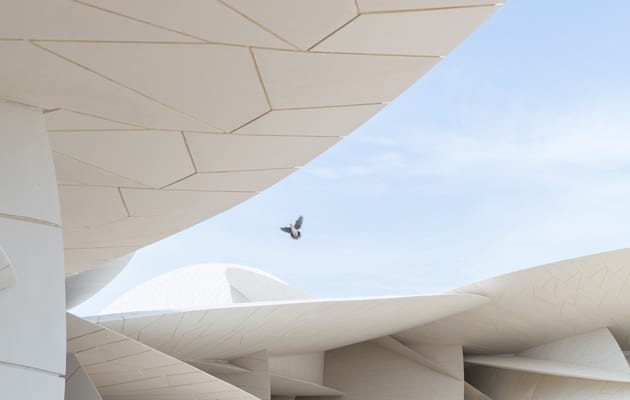 |||
|||
The National Museum of Qatar opened its doors to the public on March 28, inviting both Qatari residents and tourists alike to experience a uniquely immersive retelling of the region’s rich history.
Conceived by French architect Jean Nouvel, under the patronage of His Highness Sheikh Tamim bin Hamad bin Khalifa Al Thani, the 52,000sq m building fulfils a long-term ambition of implementing a strong and sustainable cultural infrastructure for Qatar.
Located on a prominent 14.7ha site on Doha’s Corniche waterfront promenade, Nouvel’s creation cuts a striking silhouette against the Qatari skyline. The museum boasts 7,000sq m for permanent collections, 1,700sq m for temporary exhibitions, a 213-seat auditorium, two cafes, a restaurant, two museum shops and an expansive 11.2ha park: an interpretative reimagining of Qatar’s diverse landscapes.
 Jean Nouvel’s National Museum of Qatar. Photos by Iwan Baan
Jean Nouvel’s National Museum of Qatar. Photos by Iwan Baan
According to Nouvel: “Qatar has a deep rapport with the desert, with its flora and fauna, its nomadic people, its long traditions. To fuse these contrasting stories, I needed a symbolic element.” The “desert rose”, a naturally occurring mineral formation found in the deserts of the Gulf region, came to inspire the building’s unique form.
Designed to integrate into its immediate context, the building’s sand-coloured concrete cladding seamlessly blends the building’s exterior with the local desert environment while cleverly engineered cantilevered discs cast long protective shadows, shielding visitors from the sun as they stroll from one gallery to another.
Displayed in 11 interlinked galleries, the museum’s narrative unfolds in three distinct “chapters” – Beginnings, Life in Qatar, and Building the Nation – presenting the past, present and future of Qatar.
The 1.5km visitor’s circuit winds its way through the organic sprawling mass of interlocking discs dancing around the edge of the Howsh, a central court sitting amid the gallery spaces, culminating in the development’s crown jewel: the restored historic Palace of Sheikh Abdullah bin Jassim Al Thani.

By the architect’s own admission, his work: “does not result from considerations of style or ideology, but from a quest to create a unique concept for a singular combination of people, place and time.”
In this, Nouvel is rather singular in his architectural approach: surrendering his ego, resisting the urge to stylistically stamp his name across the building and shunning notions of the “starchitect” that so many of today’s most prominent architects adhere to – becoming somewhat of an anti-individualist lodestar in the process. Refreshingly, Nouvel appears to consider architecture as a discipline dedicated to the service of socio-cultural integration.
Although it could be argued that Nouvel’s nod to the desert rose could be construed as superficial, the underlying message it communicates is a relatively profound one. The fact that Nouvel sought inspiration from the natural world when designing the National Museum of Qatar – a building to reflect on the past, present and future of the nation – is no coincidence.
Qatar’s unprecedented economic growth is largely owed to the discovery, mining and exploitation of its own natural resources. Perhaps through the erection of this ultramodern icon of biomimetic design, Nouvel attempts to highlight the importance of preserving said resources moving forward. The Arab peninsula’s future, much like its new museum, is one of a complex, engaging and somewhat poetic nature.
Despite its urban setting on Doha’s Corniche, Jean Nouvel’s dramatic National Museum of Qatar draws its inspiration from nature






















